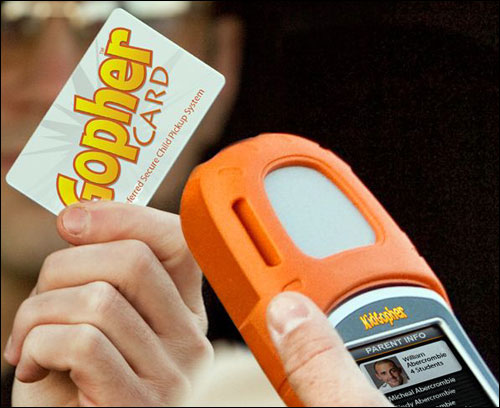Richland School District Two, in Columbia, S.C., is deploying an RFID-based solution to link parents with children at the end of a school day, to ensure that every student is picked up by an appropriate custodian, and that the school maintains a record of that event. The system, known as KidGopher, was first tested by the district at North Springs Elementary School, for several months in late 2010 and early 2011. Based on the testing results, the district is now installing the solution across all 17 of its elementary schools. District officials have declined to comment on the system’s benefits for this story, but have confirmed that technology is being deployed at its schools.
School dismissal time can be hectic. Typically, staff members must personally approve each child’s pick-up by an adult before that student leaves the school. Confusion can lead to misunderstandings or mistakes, however. For example, a parent may arrive to retrieve his or her child after that student has already departed with a friend’s parent, or another custodian—or, in the worst-case scenario, a person unauthorized to take that child. As a result, in some cases, employees may be unsure of who picked up a particular student, when questioned by distraught parents. CQ Media Networks designed the KidGopher system to address these problems.

For the pilot, North Springs Elementary School provided SecuraKey RFID-enabled ID cards complying with the ISO 15693 standard—purchased by CQ Media Networks from Fast RFID—to approximately 200 parents, known in the system’s lingo as “gophers.” Upon registering with the system, parents and any other adults authorized to pick up students have their pictures taken at the school office. They provide their names, along with those of their children who are students at the school, and any other kids whom they are permitted to take home. The Gopher card’s unique ID number is then read using an RFID interrogator cabled to a PC in the office, and linked in the KidGopher software to the personal information for that adult, whose name is printed on the back of the card.
Upon arriving at pick-up time, a parent presents his or her card to a staff member positioned at the front of the queue of vehicles located outside the school, and indicates which child or children he or she is picking up. School personnel are given a Juniper Systems Archer Field PC handheld device fitted with an RFID reader, which they can use to read the unique ID number on the card’s RFID inlay, with a read range of about 3 inches. That data is transmitted via a Wi-Fi connection to the KidGopher software—running on a server located at the school—thereby indicating who has arrived. At the same time, on the handheld’s screen, the staff member sees the individual’s name and picture, along with a list of children he or she is permitted to take home. The employee selects the names of the kids indicated by that parent, who is instructed to pull forward to a second queuing area, where the students are then released. (If the student names indicated by the parent do not match those listed in the software, the school employee can instruct the adult to enter the school to speak with the office staff.)
The KidGopher software forwards the names of the children being picked up, for display on a monitor located in the school cafeteria, where the children wait prior to being released. Teachers and other personnel watch the monitor, and as each child’s name appears, that student is approved to exit the cafeteria and line up at a pickup point, where the parents’ vehicles are queued up.
At the pickup location, another staff member is positioned, equipped with an Apple iPad. The KidGopher software sends the name and picture of each child being picked up to the iPad, and an employee confirms that student’s identity before the child enters the car. The students are released in the same order in which the parents presented their Gopher Cards, so the staff knows that the next car in the queue is the vehicle approved to pick up the next child or children listed on the iPad. The employee then presses a prompt on the device, thereby recording the student’s release to his or her parent.
The software stores the transaction so that if another parent or custodian arrives to retrieve a child no longer waiting to go home, the school has a record detailing who performed the pick-up.
CQ Media Networks, developed the KidGopher system about a year ago, according to Neil Willis, the company’s CEO, as a tool for preventing child abduction. Development involved visiting numerous schools and reviewing the ways in which children were picked up, as well as how vehicles were routed and how staff members matched adults with children.
The system can also work without RFID. In that case, the authorized “gophers” are provided with a personal identification number (PIN) that must be input prior to picking up a student at the first queuing area. However, Willis notes, the process is slower without RFID, since it requires that the gopher roll down the car window, present the card to a staff member and announce his or her PIN, which the worker then keys into a handheld device. CQ Media Networks’ PIN-based alternative solution, therefore, is less expensive but more time-consuming per transaction.
CQ Media Networks is currently in the process of developing an RFID-based solution for use on school buses. With such a system, the children, rather than the parents, would carry the RFID tags. In this scenario, each student would be provided with a wristband that could include the school logo, or other printed text or images intended to be fun for children. Embedded in each bracelet would be a passive RFID transponder. Buses would be equipped with RFID readers attached to an articulated arm located near the driver’s seat. As each child enters the bus, his or her tag ID number would be read. The ID would be linked to that particular student in the KidGopher software, and be transmitted via a cellular connection to the software running on a server installed at the school, or on a Web-based server hosted by CQ Media Networks. At that time, the software could not only store the event, but also send a text message to parents or other authorized parties, indicating that the child has been picked up by the bus. When the student exits the vehicle, the same process would occur and another text message could be transmitted to report the child’s arrival at school.
The bus system, Willis says, could be used not only for children being transported to and from school, but also for field trips, summer camps and other excursions involving children being transported via bus. He expects trials of the system to begin in the fall of this year.
With either the parent-pickup or school bus applications, data is managed by the KidGopher software, which can provide information to smaller school systems via a hosted server, or which can be installed on a larger school district’s back-end system (as is the case with Richland School District Two).


